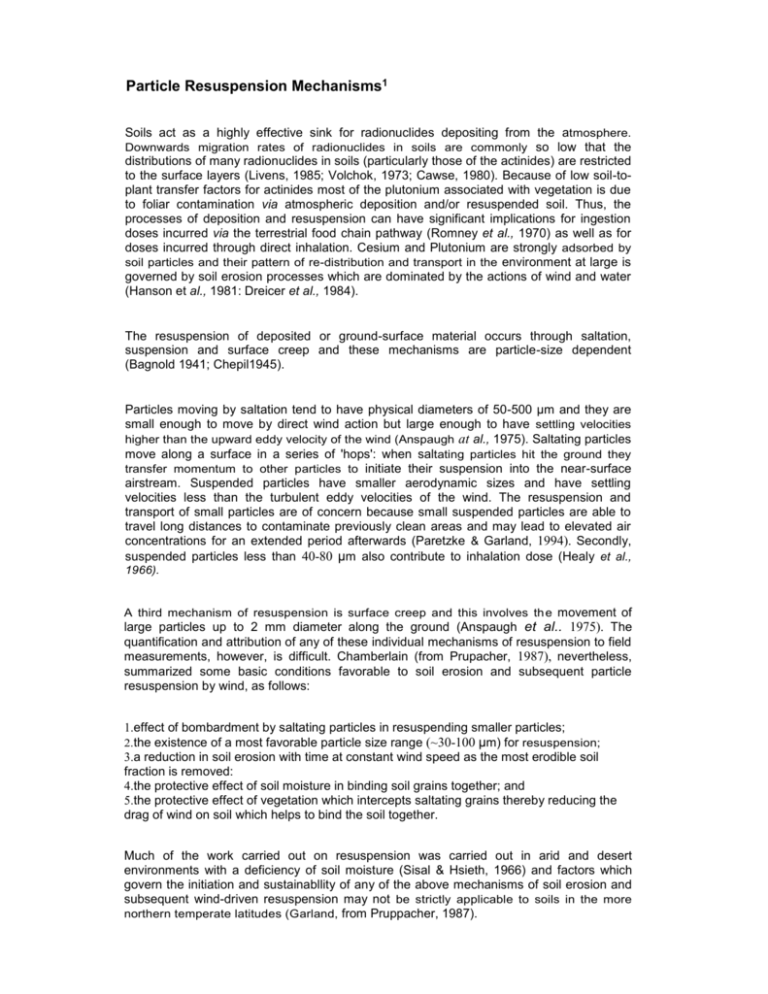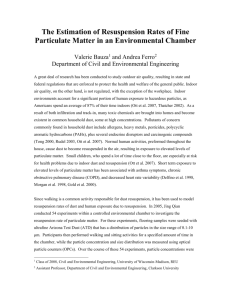particles contaminated
advertisement

Particle Resuspension Mechanisms1 Soils act as a highly effective sink for radionuclides depositing from the atmosphere. Downwards migration rates of radionuclides in soils are commonly so low that the distributions of many radionuclides in soils (particularly those of the actinides) are restricted to the surface layers (Livens, 1985; Volchok, 1973; Cawse, 1980). Because of low soil-toplant transfer factors for actinides most of the plutonium associated with vegetation is due to foliar contamination via atmospheric deposition and/or resuspended soil. Thus, the processes of deposition and resuspension can have significant implications for ingestion doses incurred via the terrestrial food chain pathway (Romney et al., 1970) as well as for doses incurred through direct inhalation. Cesium and Plutonium are strongly adsorbed by soil particles and their pattern of re-distribution and transport in the environment at large is governed by soil erosion processes which are dominated by the actions of wind and water (Hanson et al., 1981: Dreicer et al., 1984). The resuspension of deposited or ground-surface material occurs through saltation, suspension and surface creep and these mechanisms are particle-size dependent (Bagnold 1941; Chepil1945). Particles moving by saltation tend to have physical diameters of 50-500 µm and they are small enough to move by direct wind action but large enough to have settling velocities higher than the upward eddy velocity of the wind (Anspaugh at al., 1975). Saltating particles move along a surface in a series of 'hops': when saltating particles hit the ground they transfer momentum to other particles to initiate their suspension into the near-surface airstream. Suspended particles have smaller aerodynamic sizes and have settling velocities less than the turbulent eddy velocities of the wind. The resuspension and transport of small particles are of concern because small suspended particles are able to travel long distances to contaminate previously clean areas and may lead to elevated air concentrations for an extended period afterwards (Paretzke & Garland, 1994). Secondly, suspended particles less than 40-80 µm also contribute to inhalation dose (Healy et al., 1966). A third mechanism of resuspension is surface creep and this involves th e movement of large particles up to 2 mm diameter along the ground (Anspaugh et al.. 1975). The quantification and attribution of any of these individual mechanisms of resuspension to field measurements, however, is difficult. Chamberlain (from Prupacher, 1987), nevertheless, summarized some basic conditions favorable to soil erosion and subsequent particle resuspension by wind, as follows: 1.effect of bombardment by saltating particles in resuspending smaller particles; 2.the existence of a most favorable particle size range (~30-100 µm) for resuspension; 3.a reduction in soil erosion with time at constant wind speed as the most erodible soil fraction is removed: 4.the protective effect of soil moisture in binding soil grains together; and 5.the protective effect of vegetation which intercepts saltating grains thereby reducing the drag of wind on soil which helps to bind the soil together. Much of the work carried out on resuspension was carried out in arid and desert environments with a deficiency of soil moisture (Sisal & Hsieth, 1966) and factors which govern the initiation and sustainabllity of any of the above mechanisms of soil erosion and subsequent wind-driven resuspension may not be strictly applicable to soils in the more northern temperate latitudes (Garland, from Pruppacher, 1987). A fourth mechanism of soil erosion and subsequent resuspension of particles relevant to this work occurs via rain-soil splash. Dreicer et al. (1984) found that the impact of falling raindrops resuspended soil particles to a maximum height of 40 cm above ground and· the majority of resuspended particles were less than 125 µm diameter. These workers also found a linear relationship between the intensities of rainfall from four natural rainfall events and the resuspension of particle size less than 125 µm diameter up to a height of 40 cm above the ground. This mechanism of resuspension, however, is episodic and difficult to quantify under field conditions because of the range of environmental variables involved. These include the initial surface moisture before the last rainfall (antecedent soil moisture), soil type, vegetation cover, vegetation type, wind speed and particle size with activity characteristics of the depositing or deposited nuclides. On a local scale and with particular reference to nuclear fuel reprocessing plants, it is the mechanical processes of resuspension which are more important than wind borne processes of particle resuspension (Hakonson et al., 1980). Deposited material is reentrained and resuspended into the near-surface air from soils and concrete areas via a number of mechanical processes including the use of ground-intrusion machinery such as earth diggers, pile-driving equipment, vehicular tire movement and pedestrian traffic. Agricultural activities, particularly plowing and tilling, are capable of raising soil-bound plutonium and other nuclides within the near-surface air (Shinn et al., 1983) although the distribution of activity with particle size will be a limiting factor with regard to inhalation dose. Inhalation of plutonium A number of workers (Nicholson et al., 1989 :Garland, 1991) have noted that large particles greater than 20 µm diameter are more easily resuspended than smaller particles. The least resuspendible sizes are the less than 1 µm diameter particles (Gillette, 1977). The major hazard from the resuspension of plutonium is the potential inhalation of contaminated particles in specific physical size ranges (NEA, 1981; Nicholson, 1992). Particles up to 100 µm in diameter are generally thought of as being inhalable (Mark, 1995) with the less than 4 µm diameter size fraction defined as the respirable fraction (EN481: 5S EN481). Inhaled particles deposit to either the nasopharyngeal regions, the tracheo-bronchial region or the pulmonary or alveolar regions of the lungs . However, the fraction of inhaled particles which is retained in the respiratory system and the depth to which the particles penetrate before deposition is related to particle size (Brown et aI., 1950). Inhaled particles less than 0.5 µm aerodynamic diameter may be carried deep into the lung and if contaminated with radionuclides will irradiate sensitive alveolar tissue (ICRP, 1975 Burkart, 1989). Particles greater than 5 µm deposit out of the inhaled air stream via impaction or are intercepted by mucus layers within the nasopharyngeal cavity. Inhalation of contaminated particles greater than about 5 µm aerodynamic diameter is radiologically less damaging to lung tissue than particles with an aerodynamic size range less than 1 µm because this size fraction is less respirable. 1Environmental Characterization Of Particulate-Associated Radioactivity Deposited Close To The Sellafield Works In Great Britain, A thesis submitted for the degree of Doctor of Philosophy, Imperial College of Science, Medicine and Technology, Ellis Induro Evans, (October, 1997).








